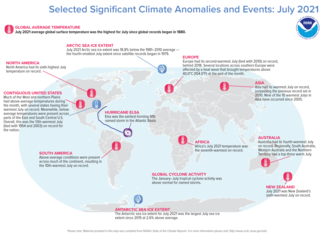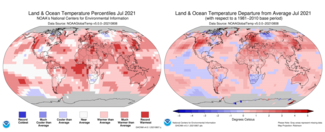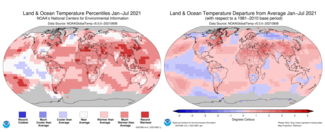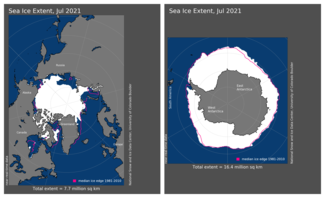July 2021 was the warmest July on record for the globe; global land surface was also record warm

The global temperature for July 2021 was the highest for July in the 142-year NOAA record, which dates back to 1880. The year-to-date (January-July) global surface temperature tied as the sixth highest on record. According to NCEI’s Global Annual Temperature Rankings Outlook, it is very likely that the year 2021 will rank among the 10 warmest years on record.
This monthly summary, developed by scientists at NOAA’s National Centers for Environmental Information, is part of the suite of climate services NOAA provides to government, business, academia and the public to support informed decision-making.
Monthly Global Temperature
The July 2021 global surface temperature was 1.67°F (0.93°C) above the 20th-century average of 60.4°F (15.8°C) — the highest for July in the 142-year record. This value was only 0.02°F (0.01°C) higher than the previous record set in 2016, and tied in 2019 and 2020. The seven warmest Julys have all occurred since 2015. July 2021 marked the 45th consecutive July and the 439th consecutive month with temperatures, at least nominally, above the 20th-century average.
Climatologically, July is the warmest month of the year. With July 2021 the warmest July on record, at least nominally, this resulted in the warmest month on record for the globe.
The global land-only surface temperature for July 2021 was 2.52°F (1.40°C) above average and the highest July for the land-only surface temperature on record, surpassing the previous record set in 2020 by 0.31°F (0.17°C). The warmth across the global land surfaces was mainly driven by the very warm Northern Hemisphere land, which also had its highest July temperature at 2.77°F (1.54°C) above average.
During the month, temperatures were much warmer than average across parts of North America, Europe, northern and southern South America, northern Africa, the southern half of Asia, Oceania and parts of the western and northern Pacific, the Atlantic and Indian Oceans. Temperatures were cooler than average across parts of northeastern Canada, the south-central and southeastern contiguous U.S., southern Africa, northern Russia and the southeastern Pacific Ocean.
Regionally, Asia had its warmest July on record, besting the previous record set in 2010. Europe had its second-warmest July (tied with 2010) on record, trailing behind the record warm July set in 2018. Meanwhile, North America, South America, Africa and Oceania had a top-10 warm July on record.
July Tropical Cyclones
In the Atlantic basin, one named storm formed during July 2021. Hurricane Elsa, which formed on July 1, was the earliest-forming fifth named storm in the Atlantic basin. The Eastern North and Western Pacific basins each had three named storms. Overall, the global tropical cyclone activity from January-July was above-normal for named storms.
July Sea Ice
The July 2021 Arctic sea ice extent was 687,000 square miles below the 1981-2010 average and was the fourth-smallest July sea ice extent in the 43-year record, according to an analysis by the National Snow and Ice Data Center (NSIDC) using data from NOAA and NASA. Only Julys of 2012, 2019 and 2020 had a smaller sea ice extent in July. The 10 smallest July sea ice extents for the Arctic have occurred since 2007.
The Antarctic sea ice extent during July 2021 was above average. The July Antarctic sea ice extent was 6.32 million square miles — the largest July sea ice extent since 2015 and the eighth highest in the 43-year record.
For a more complete summary of climate conditions and events, see our July 2021 Global Climate Report.







